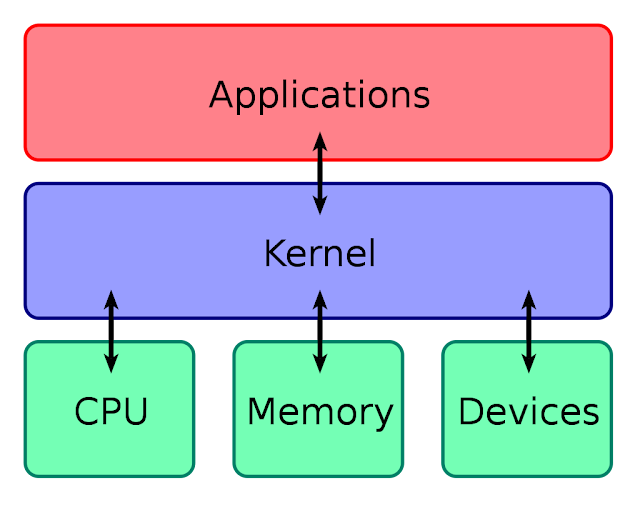 |
| By Bobbo - Own work, CC BY-SA 3.0, https://commons.wikimedia.org/w/index.php?curid=4392180 |
In the context of computer science and operating systems, a kernel is the central component of an operating system. It acts as an intermediary layer between the hardware and the software applications, enabling communication and coordination between the two. The kernel is responsible for managing system resources, providing essential services, and ensuring the proper functioning of the entire system.
Here are the main functions and responsibilities of a kernel:
Memory Management: The kernel manages the system's memory, allocating and deallocating memory space for running processes and ensuring efficient memory usage.
Process Management: The kernel is responsible for creating, scheduling, and terminating processes. It allocates CPU time to different processes, allowing multiple programs to run concurrently.
Device Drivers: The kernel includes device drivers that facilitate communication between hardware devices (such as printers, network cards, and storage devices) and the operating system.
File System Management: The kernel handles file system access and management, including reading and writing data to storage devices and organizing files and directories.
Security: The kernel enforces security policies and access controls to protect the system and its resources from unauthorized access or malicious software.
Interprocess Communication: The kernel facilitates communication between different processes, allowing them to exchange data and synchronize their activities.
System Calls: The kernel provides an interface known as system calls that allows applications to request services from the operating system, such as file operations, network communication, and process management.
Examples of kernels:
Linux Kernel: The Linux kernel is the core component of the Linux operating system. It is an open-source kernel developed collaboratively by a vast community of developers worldwide.
Windows NT Kernel: The Windows NT kernel serves as the foundation for modern Windows operating systems, including Windows 7, Windows 8, Windows 10, and Windows Server versions.
macOS Kernel (XNU): XNU is the kernel used in macOS and iOS devices. It is a hybrid kernel that combines elements of both monolithic and microkernel architectures.
Android Kernel: Android uses a modified version of the Linux kernel as its core. This modified kernel is designed to work with the Android operating system and the hardware it runs on.
FreeBSD Kernel: FreeBSD is a popular open-source Unix-like operating system, and its kernel serves as the core component of the FreeBSD OS.
Each of these kernels has its unique design and features, but they all serve as the critical bridge between hardware and software, ensuring the proper functioning of the operating system and enabling users to interact with their computers and devices effectively.

No comments:
Post a Comment
Contact The Wizard!
(he/him)